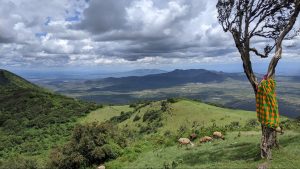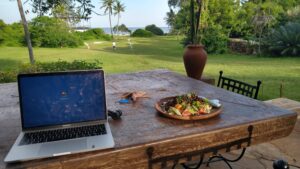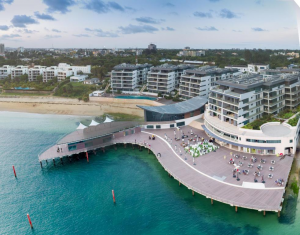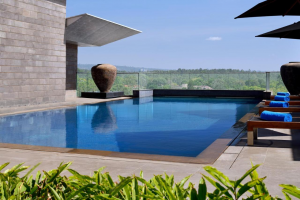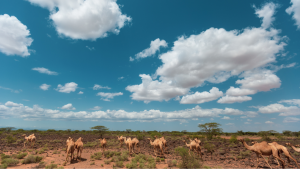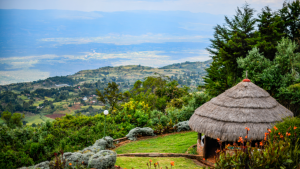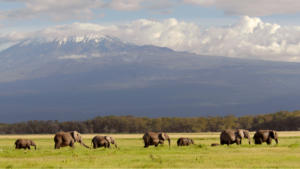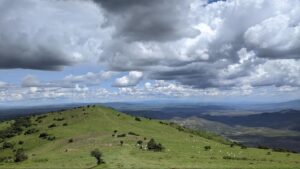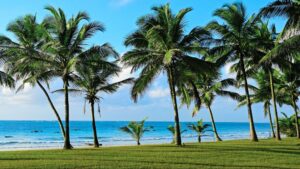Nothing prepares you for when you first witness the great migration in Kenya. Wildebeests, as far as the eye can see, roaming the open plains followed by their crossing of the treacherous crocodile-infested Mara river. It’s a thrilling spectacle.
In this migration, wildebeests, zebras, and gazelles leave the dry plains of the Serengeti in Tanzania in search of water and pasture in Kenya’s Maasai Mara.
It’s an exciting wildlife event, and we can’t recommend it enough. We want to prepare you for it. From when and where, to what to pack, we have every detail so your experience of the great migration in Kenya is unforgettable.
When To See The Great Migration
The migration is wholly dependent on weather patterns, with the wildebeests usually following the seasonal rains. From December to March or April, the herds are in Serengeti National Park in Southern Tanzania. In April, as the weather in South Serengeti dries up, the animals migrate and graze along the West Serengeti.

By June, they will have made their way to North Serengeti near the Kenyan border and will cross the Mara River into the Maasai Mara reserve in July. The timing of the crossing all depends on nature, and due to the change in seasons, sometimes the river crossings start earlier or later.
We recommend keeping an eye out for information online. Many of the camps and tour companies offering this safari experience will keep you updated on when the crossing might happen.
Best Time to See the Great Migration in Kenya
From July, the great migration in Kenya will have begun. In dramatic fashion, thousands of wildebeests cross over, while trying to escape lions, crocodiles, and other predators lurking on land and in water.
You can catch the migration in the Maasai Mara all the way to October as wildebeests cross back and forth.
Depending on when it starts, July to October is the peak season for the great migration in Kenya. During this time, the chances of seeing a river crossings are quite high. The herds are also usually massive during this time which adds to the magnificence.

The only downside is that the area is usually packed with tourists. Personally, I think the energy that emanates from the large crowds witnessing the event adds to the experience.
But I also understand if you need to experience it alone or with fewer people. If that’s the case, we recommend seeing the migration in late October and early November as the animals start their trek back to the Serengeti.
The advantage will be the quiet that comes with fewer people, but unfortunately, by this time, the herd will have thinned, and only a few will be crossing back and forth.
See the Great Migration in Tanzania
If you don’t see the great migration in Kenya, you can do so in the Serengeti in Tanzania.
As we had mentioned earlier, between December and April, the animals are in the Serengeti in South Tanzania. This period is also calving season, so the wildebeests, zebras, and other animals are in high numbers. The Serengeti then is lush and the landscape stunning. It makes for a lovely visit.

As late April and early May rolls around, the migration up North begins through the Western corridor of the Serengeti. The animals face their first huddle in their migration which is crossing the Grumeti river. Here, you can watch the wildebeests’ dramatic fight for survival against crocodiles.
By July or August, the herd will have made it to North Serengeti to cross over the Mara river into the Maasai Mara reserve. They will travel back to the Serengeti in November and December as they once again begin the trek back to South Tanzania.
The Serengeti is a year-round destination, and several camps offer this safari experience. The trick is to pick the right part of the Serengeti, depending on the time of the year.
The challenge with watching the great migration in Tanzania is that it’s not easily accessible and may not be suitable for large groups and families. On the upside, it is not a common destination therefore it is quieter compared to the great migration in Kenya.
How to See the Great Migration
So, you’ve decided you want to see the great migration in Kenya, where do you start?
First is getting to the Mara. You can choose to travel by road, in which case, there are many tours and travel companies that offer transportation depending on your needs. There are many options for 4 wheeled cars or safari vans. The roads leading towards the Mara conservancies and the Mara Park aren’t paved and can be challenging especially during the rainy season.

If you are short on time, you can take a flight to the Mara. Flying also provides you a breathtaking aerial view of the region. There are several domestic flights which will drop you at an airstrip nearest your accommodation.
Next up is accommodation and for this, you have the option of mobile camps or permanent lodges.
Mobile Camps
There are mobile camps set up in conservancies all over the Mara specifically during the peak migration period. These camps are usually located near migration routes. They are almost always only set up between June and October.
Thanks to their access, they offer a front-row seat of the great migration in Kenya. They are very popular; you may need to book months in advance to get a spot.
Sanctuary Maasai Mara Seasonal Camp is a small intimate camp set up at the banks of the Mara River. They are available from the end of June to the end of October and offer several safaris, including the chance to see the great migration up close. They go from $630 per person per night.
Another popular mobile camp is the Leleshwa Seasonal Camp, located in the South of the Mara reserve. It is open from June to October and closes once the herds move. They are popular for bookings with private groups of vacationers wishing to spend time with family and friends.
Porini Mara Camp is a non-seasonal safari camp set in a private conservancy -Ol Kinyei Conservancy- near the Mara reserve. They contain only five tents and one family unit. It costs from $395 per person per night on full board. They offer several safaris and will take you to several river crossings to watch the great migration.
If you are looking for something luxurious then the Mara Bush Camp is for you. It’s a boutique luxury tented camp inside the Mara reserve. In addition to being able to see the great migration from here, they have a large hippo pool on the river next to the camp.
Other camps include Kichwa Tembo Tented Camp, Mara Intrepids Camp, Rekero Camp and Little Governor’s Camp.
Permanent Lodges
There are plenty of permanent lodges in Mara you can stay at as you experience great migration in Kenya. Most of them stay open even after the peak migration season.
Angama Mara is a beautiful hotel overlooking the hills of the Mara Triangle escarpment. The best part is that they are only 20 minutes from the Mara, where the wildebeest river crossings occur. They also have a private airstrip if you decide to fly into the Mara. Stays start from $1,250 per person sharing.
The Fairmont Mara Safari Club is in the Maasai Mara Game Reserve. Their accommodations feature luxuriously furnished tents and private decks overlooking the hippo filled Mara River. They have safari vehicles for game drives and are located only a few minutes from the wildebeests’ river crossings.
Mara Serena Safari Lodge is also an option if you are looking for accommodation during the migration season. They are located inside the Maasai Mara reserve. They usually have packages from $650 during the migration season that includes accommodation, meals, flights, and safaris.
Mara Chui Resort is located East of Maasai Mara and offers safari adventures, among them seeing the Great Migration in Kenya.
Most tourists experience the migration on the ground, but you should try a hot air balloon safari for a different perspective. Most launch at dawn so you can catch the sunrise. It offers fantastic views of the plains and of course an unobtrusive view of the herds below.

Whether you are staying at a mobile camp or a permanent lodge, it’s essential to give yourself enough time to experience the great migration in Kenya. At the very least we recommend you set aside two days for this experience. You can even stay for up to six days, depending on your budget.
Along with watching the migration, you can see the big five on safari as well. The Maasai Mara National Park offers exquisite sunrises and sunsets over the savannah plains. Some hotels, lodges, and camps will also provide a brief history of the Maasai culture with Maasai guides during your stay.
What to Pack for Your Safari
When packing for your safari, consider the weather and comfort. For the most part, it’s important to pack minimally – especially if you intend to fly to the Mara. Most local flights have a luggage restriction of 15 Kgs per person including carry-on bags.
Clothing suitable for safaris is essential. Include a wind jacket or raincoat for the cold mornings, a sweater or fleece jacket for the chilly nights, hiking or gym shoes for walking safaris, and sandals for when in the camp or lodge.
It gets sweltering during the day so pack sunscreen, sun hut, and sunglasses. We also recommend carrying insect repellant, painkillers, and vital medication. Do not forget your health cards like your yellow fever certificate.
To make sure you don’t miss a thing carry binoculars and to make sure you won’t forget a thing, carry a camera.
Finally, we could go on and on about how the great migration in Kenya is incredible. The bottom line is it’s an unforgettable experience you should try. When you do let us know in the comments below, were we right? Or were we right?

